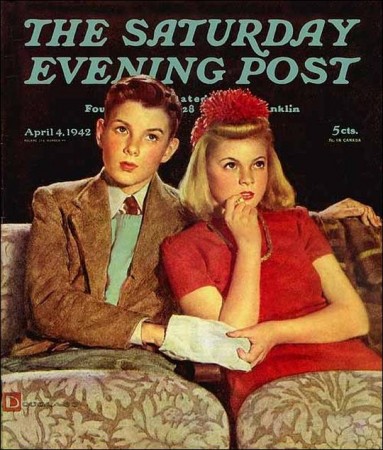The rise of Hollywood signaled the arrival of America’s urban-industrial age, a period when traditional values and established notions of family and community, of the social and political order, and of individual freedom and initiative were radically transformed. Hollywood movies were among the first and were certainly the most widespread and accessible manifestations of an emergent “mass culture” which brought with it new forms of cultural expression.
Businessmen began to realize the financial potential for movies. While movies were first shown as part of other forms of entertainment, they soon became the featured attraction themselves. By 1905 the first nickelodeon had opened in Pittsburgh, where customers each paid a nickel to see a full program of a half dozen short films. The opening of theaters completed the elements necessary for an industry: product, technology, producer, purchaser, and distributor. As the United States became an increasingly child-centered culture, concern grew about the moral effects of popular culture on the young.
This was not simply a matter of its content: many educationalists shared philosopher Charles Horton Coolef’s disquiet about its “expressive” function in stimulating emotions. The “rapid and multitudinous flow of personal images, sentiments, and impulses”, he feared, produced “an overexcitation which weakens or breaks down character”.
One man who learned his trade from Griffith was Mack Sennett. Sennett worked for Griffith for a few years as a director and writer, but his interests were more in comedy than in melodrama. In 1912 he broke away and began to work for an independent company, Keystone. Here he learned to merge the methods of stage slapstick comedy with the techniques of film; the results were the Keystone Cops, Ben Turpin, and Charlie Chaplin. Sennett’s films used only the barest plot outline as a frame for comic gags that were improvised and shot quickly.
From the Sennett method, Charlie Chaplin developed his own technique and character. He began making shorts under the direction of Sennett, but in 1915 he left and joined with Essenay which agreed to let him write and direct his own films at an unprecedented salary. Here he fleshed out his tramp character; one of his first films for Essenay was The Tramp (1915). He continued making films that combined his own comic sense and acrobatic movements with social commentary and along with Mary Pickford became one of the first “stars.”
Later he made features, such as The Gold Rush (1925) and Modern Times (1936). Sennett and Chaplin began a period of great film comedy. Buster Keaton combined a deadpan look with remarkable physical ability and timing. He too began making shorts, but soon was directing and starring in features, such as The General (1926). Harold Lloyd ( The Freshman, 1925) and Harry Langdon ( The Strong Man, 1926) also created comic characters that demonstrated their individuality and imagination.
Related Links
Continue Reading
View More Popular Culture Articles
Views: 323





